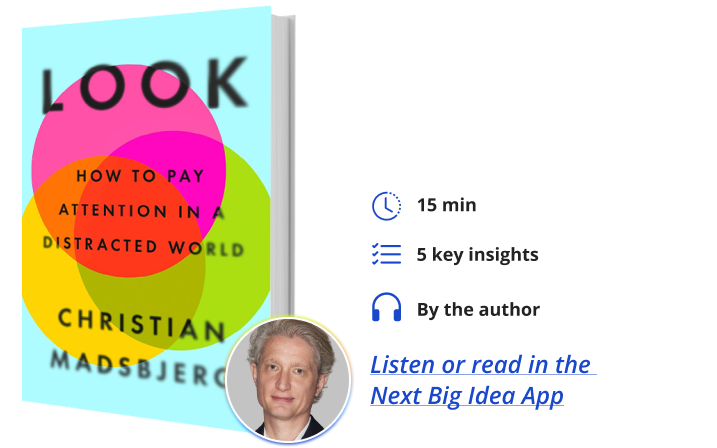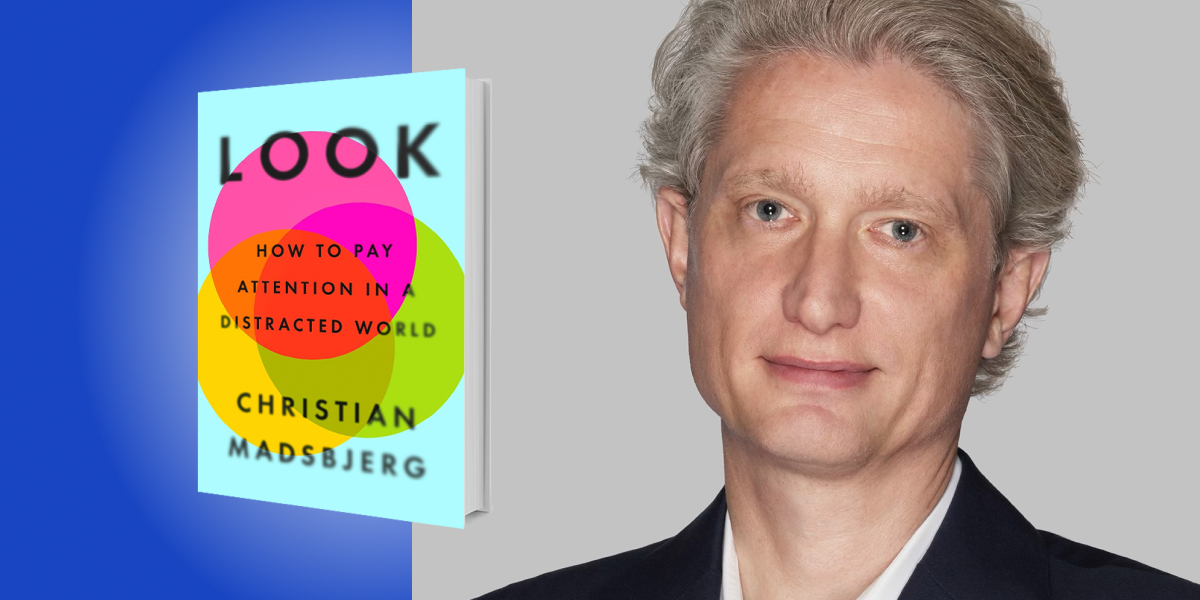Christian Madsbjerg is a professional observer who helps leaders observe their customers, employees, constituents, and patients. He is the founder of ReD Associates and studied philosophy and political science in Copenhagen and London. His work has appeared in The Wall Street Journal, The Atlantic, Financial Times, The Washington Post, and Bloomberg Businessweek.
Below, Christian shares five key insights from his new book, Look: How to Pay Attention in a Distracted World. Listen to the audio version—read by Christian himself—in the Next Big Idea App.

1. Learning to pay attention is a skill.
We don’t expect to sit down at the piano and immediately know how to play Beethoven. So, why do we think we can walk into a high-stakes meeting or an event of great consequence and intuitively understand what to pay attention to and why? Most of us can’t. Normally, we only pay attention when we absolutely have to.
If we have any hope of mastering and understanding how to pay attention, we need to begin by describing it accurately; this is our first challenge. We assume that attention is just about focus, but the reality is that there are three forms of attention, and focus plays a very small role.
2. Panoptic attention is everyday attention.
Panoptic attention is ordinary. Think about when you open your front door and walk down the street. What do you perceive? You might see a group of children heading to school, shoppers, cars in traffic, or a large truck coming down the road. You probably don’t pay careful attention to the exact color of the truck or its year and make. Instead, your perception takes in the entire social context of what you are seeing, a street scene, and an understanding of what a truck is snaps into place. This is what’s called panoptic attention. You don’t need to cultivate panoptic attention, and most of the time you’re not even aware of it. Panoptic attention is how most of us move through and perceive the world on any ordinary day.
3. Focused attention functions as a spotlight.
This way of paying attention is about zooming in with a focus on certain things. In the above example of opening your front door, if that same truck is approaching and you need to know its make and model, you will focus your attention to find out whether it is a Mercedes-Benz Sprinter or an electric van from Rivian. This is the same kind of focus we use on any activity that requires us to put our spotlight on a task.
“Focus plays a very small role when it comes to combatting distraction.”
When we take a standardized test, for example, we use focus. When we look through a microscope, we focus on what is underneath that magnifying lens. We assume that when we are distracted, it is because we lack focus, but according to the most accurate philosophy, that is incorrect. The reality is that focus plays a very small role when it comes to combatting distraction.
4. Hyper-reflection enhances our understanding of the world.
“Hyper-reflection” is paying attention to how other people pay attention: seeing yourself seeing, and, therefore, seeing how other people see. “Hyper reflection” is a meta-skill that allows us to observe how others make sense of their world and move through life.
Great journalists, ethnographers, and master artists exemplify “hyper-reflection” as its best: They pay attention to what people say and do and interpret others’ behavior for the rest of us. If each of us were to learn this attentional skill, we would start seeing human behavior in structured, highly empathetic ways. We would start to understand other people better and perhaps even more importantly, we could arrive at insights about why this type of behavior is happening.
5. Hyper-reflection shows us a world without abstraction.
Ten years ago, the Ford Motor Company wanted to transform the world’s most popular truck, the F150, into an electric vehicle. In this scenario, they could have easily ended their attention with focus—without taking that extra step. There was plenty for them to focus on, everything from the vehicle engineers’ passion for design and mechanics to the experiences of devoted truck drivers living all across North America. Not only is the F150 an icon of American culture, but it has also kept the lights on in Detroit for years. Any tweak in the wrong direction would have consequences that would roil the entire industry, not to mention threaten to take down the Ford Motor Company.
The amount of data involved in the project was distracting and it became clear that focus was not the solution. Instead, they needed to understand how the F150 drivers related to electric vehicle concepts like the environment and climate change. How could they help the company pay attention, not to what either the drivers or the engineers were telling them, but to the greater context of how people related to their trucks? What was the difference for them between the outdoors and the environment? How could they see, really see, what the F150 drivers were seeing?
“The amount of data involved in the project was distracting and it became clear that focus was not the solution.”
While the drivers were not opposed to electric, they also weren’t motivated to buy a truck based on abstract data measuring CO2 emissions. They needed to know that their trucks would work for them in everyday contexts, bringing them to an off-the-grid campsite, or helping them haul a boat for a weekend of fishing with the family. In this way, the F150 drivers considered themselves conservationists and stewards of the environment. They just needed their truck to deliver on the practical demands of rugged, low-density living, not on greenhouse gas metrics.
“Hyper-reflection,” paying attention to what other people see, revealed this possibility for the transformation of North America’s best-selling vehicle. It could be framed not as better for the environment but as a truck that was first class for its practicality outdoors. In April of 2022, Ford released its F-150 Lightning and it has been leading sales of EV trucks ever since.
When “hyper-reflection” is practiced, observing others in their social context without prejudice or preconceptions, the world shows up without abstraction. This can help us prioritize what’s important so that distraction and languishing dissipate. When you arrive at an insight, when you learn to see what is really there, that is a moment of exhilaration and wonder.
To listen to the audio version read by author Christian Madsbjerg, download the Next Big Idea App today:































